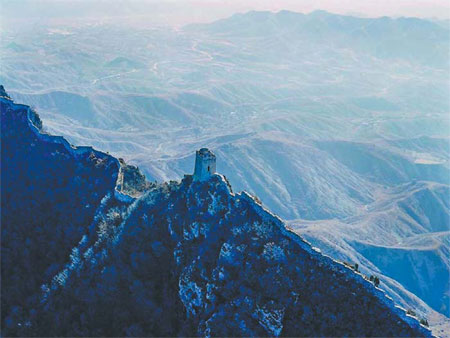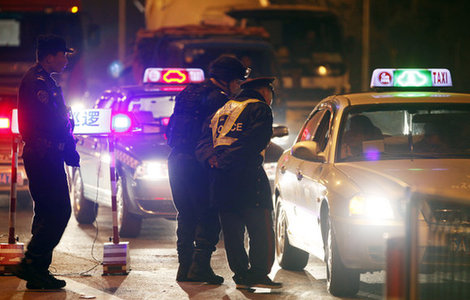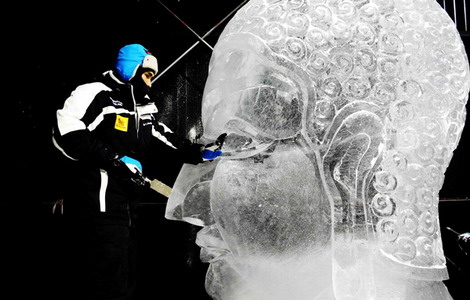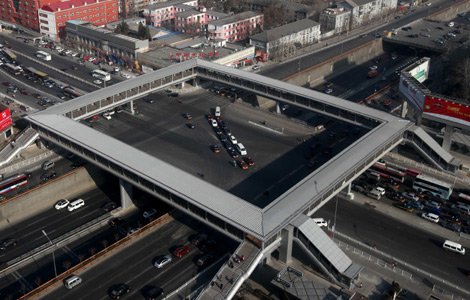The Great Wall, The Great Defender
Updated: 2012-01-08 08:01
By Peter Hessler (China Daily)
|
|||||||||


David Spindler first started hiking the Great Wall in 1994, when he was the only American studying for a master's degree at Peking University. He had always been athletic - at Dartmouth, he'd rowed varsity crew and was on the cross-country ski team - and he saw hiking as the perfect break from city life. At Peking University he wrote a master's thesis in Chinese about Dong Zhongshu, a philosopher in the Western Han Dynasty (206 BC-AD 24).
After receiving his degree, Spindler decided against pursuing a career in academia. For a spell, he worked as an assistant in CNN's Beijing bureau, and then became a China market analyst for Turner Broadcasting. But neither journalism nor business felt right, and the only constant in those years was hiking the Great Wall.
In October (2006), I accompanied Spindler on his 331st journey into the field. By public bus and minivan, we traveled to a remote village called Shuitou. In 2003, while visiting the Wall here, Spindler had seen some high ridges he thought might contain more fortifications.
The harvest was nearly finished, and the wind rustled stalks of corn that stood dead in the fields. Beyond the village, we climbed a steep section of the Wall, where thousands of Mongols had attacked in 1555. Spindler said that the typical Chinese defense relied on crude cannons, arrows, cudgels and even rocks.
"There were regulations about how many stones you were supposed to have, and how you were supposed to bring them to the second floor of the tower if there was an attack," he said. Later he pointed out a circle of loose stones that had been carefully arranged atop the Wall. Four and half centuries later, they were still awaiting the next attack.
The Mongols liked to come at night. They traveled on horseback, usually in small groups. Near enemy territory, they followed ridgelines, because they feared ambushes. They were not occupiers. They penetrated Han Chinese lands, gathered booty and returned home as quickly as possible. They liked to steal livestock, valuables, household goods and Han people. They carried the men and women back to the steppes and forced them to form families. Then they sent the men south to gather information on Han defenses, using their wives and children as hostages.
The most vivid accounts of the Mongols were provided by Han Chinese officers who served in the north. Yin Geng, the author of a book that Spindler read in Japan, had particularly intimate contact with Mongols during the mid-fifteen hundreds.
("They like to fornicate, paying little attention to whether it's day or night or whether there's any one watching.") Like most Ming writers, he calls them lu - barbarians. ("Every barbarian brews alcohol and all of them like to drink; the barbarians drink like cattle, not even stopping to breathe in the process.")
His account is a dark sort of anthropology, written in the hope that the reader will come to both know and hate the enemy. ("Barbarians like to spear babies for sport.")
Historian Arthur Waldron identifies three basic Ming strategies for dealing with northerners. In the early Ming, the Han Chinese often took the offensive, pushing Mongol settlements away from the frontier. The second approach was buying off key Mongol leaders with gifts, official titles or opportunities for trade. But some Ming emperors refused to negotiate with people they believed were savages.
The third option was to build defensive walls - an ineffective tactic, in Waldron's view, and one that he compares to the Maginot Line. Wall building became the trademark of the later Ming, he writes, because the dynasty had become too weak to fight and too proud to conduct diplomacy.
Spindler believes that the late-Ming response was less rigid than that. In his reading, he has found that the Han Chinese tactics varied locally, depending on the specific threats. And wall-building was often coordinated with offensive and accommodationist strategies.
In any case, he is convinced that no Han Chinese policy could completely resolve their problems with the Mongols, whose internal power struggles contributed to the raiding.
In Mongol culture, legitimate leadership was supposed to be confined to the direct heir of Genghis Khan, and to pass only to the firstborn son of each generation. Outside that narrow line, ambitious contenders often found that the easiest opportunities to gain status lay in the south.
In the 1540s, Altan Khan was frustrated by his genealogical standing - he was the second son of a third son - and so he attempted to improve his lot by establishing trade relations with the Han Chinese.
The reigning Ming emperor, Jiajing, refused. On Sept 16, 1550, the night of the Mid-Autumn Festival, Altan Khan led tens of thousands of Mongols on a surprise attack northeast of Beijing. They breached the crude stone walls there and pillaged for two weeks, killing and capturing thousands of Han Chinese. After that, the Ming began using mortar on a large scale to improve the fortifications.
The oldest son of Altan Khan, known as the Yellow Prince, tried a different strategy.
He married dozens of women from important Mongol families as a means of solidifying his alliances with them. But he began to have financial problems, which he solved by sending the women back. Accompanied by their families, the ex-wives began visiting Han wall garrisons, demanding support.
In 1576, after one such appeal was rejected, a raiding party penetrated a gap in a remote part of the defense network. The region was so rugged that the Ming believed no wall was necessary, but the Mongols got through, killing 29 Han Chinese.
The Ming responded with another major wall-building campaign, this time using brick, which allowed construction on even the steepest terrain. Spindler calls the incident of 1576 "the raid of the scorned Mongol women" - a failed harem that helped to inspire the stunning brick fortifications of Beijing.
Historians generally portray the Great Wall as a military failure and a waste of resources.
Spindler disagrees, noting that the improved Wall held back major attacks in the 16th century. At Shuitou, where we hiked, the Han Chinese defeated thousands of Mongols. For the Ming, the Wall was only part of a complex foreign policy, but, because it's the most obvious relic, it receives disproportionate blame for their fall.
Peter Hessler is the former New Yorker correspondent in China, now based in Cairo. He is a 2011 MacArthur Foundation Fellow, and the author of three books about China. This story is excerpted from a 2007 article in the New Yorker with permission of the author.
For China Daily
Hot Topics
Kim Jong-il, Mengniu, train crash probe, Vaclav Havel, New Year, coast guard death, Internet security, Mekong River, Strait of Hormuz, economic work conference
Editor's Picks

|

|

|

|

|

|







